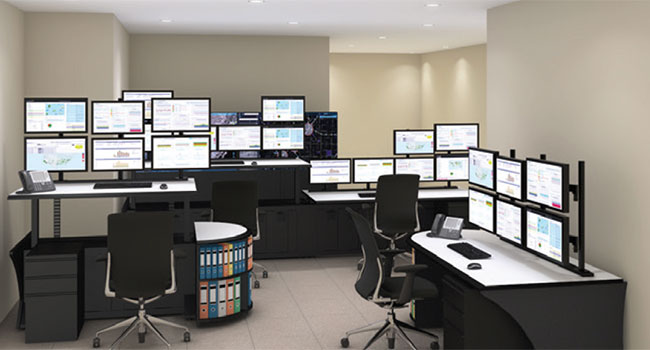
An Optimal Control Room
University of Toronto builds out comfortable room of campus police unit
- By Randy Smith
- December 16, 2020
Campus safety is one of the largest issues facing universities.
In 2014, more than 27,000 criminal incidents were reported
at public and private universities across the United States*.
This number can be particularly high for universities
located in congested city landscapes, like the University of
Toronto.
The University of Toronto is located in the downtown area of the
city. Due to the location, the campus sees foot traffic from roughly
100,000 students and patrons each day. Ensuring the safety of its students
is a tall order, and the responsibility falls on the university’s
public safety unit, the campus police.
Ensuring student safety against a variety of threats is no easy task.
Campus Police Service must be able to respond and react to a situation
at a moment’s notice. To do so, it requires seamless communication
over miles of campus space with tens of thousands of people. It
is simple – communication, whether it’s with each other, fellow students,
faculty or the local police, this is the key to the job.
In 2013, campus police realized their communication center,
which services the entire tri-campus university, was in need of a renovation
to better serve and protect its students. But the space itself
had its challenges. A partnership with Winsted Corp. helped turn
around the comfort and productivity of the spaced allotted for a security
operations center.
Little Room to Work With
The University of Toronto Campus Police had limited workspace,
compounding an already challenging situation. Unfortunately, these
space limitations can be common among universities. As student
populations rise, space becomes a valuable commodity around
campus.
“We knew we had space restrictions because everything needed to
be housed in one central room, and that space is roughly 20 feet by 40
feet, said Alan Truong, manager, Security Systems and Services of
The University of Toronto Campus Police. “When we were looking at
our renovation and development plan, we were trying to fit everything
in terms of access control, 24/7 employee use along with all of
the operational systems required.”
This 800-square foot space needed to include multiple desks, a
video screen and a scalable computer monitor stand for the 80-plus
employees to use on an ongoing basis.
Campus police began working with Minneapolis-based Winsted, a
manufacturer of technical furniture and control room consoles. Win-sted has installed control room consoles and furniture for universities,
company world headquarters, national monuments and casinos.
The selection of furniture and consoles is used and configured for
many other installations as well.
Working with a local architecture firm, the campus police engaged
Winsted to partner with them and help meet the challenges of the
small, but critical control space.
Limitation Meets Opportunity
Tasked with meeting the specific needs of campus police in a confined
space, the Winsted team scouted the location to determine how best
to maximize square footage.
“Although our space was limited, Winsted presented us with a variety
of options that would have worked well for our needs,” Truong
said.
Meeting a challenge, the team was able to offer the police service
many different types of desk set ups, wood and stains, all that fit
within their space constraints.
Campus police was outfitted with a series of six Ascend consoles
with custom millwork. The Ascend consoles include many features
that lend themselves to critical control rooms, including Versa-Trak
monitor mounting system, electric-lift legs, easy-access cable management
and multiple-purpose doors.
To complement the consoles offer three programmable height settings
for versatility and comfort, allowing the desks to be adjusted to
any height. This is a particularly helpful feature when multiple communications
officers use the same space on any given day.
Within a few months the newly designed room was fully outfitted
and operating smoothly. From conception to installation.
“They were with us since day one, which is great,” Truong said.
“Communication was always open and their reps would follow up
with everything we asked of them. They still follow up with us to
make sure we have absolutely no problems.”
Functionality for Safety
In an important room with limited space, every inch needed to be
used to its fullest potential to achieve success. The same could be said
for the University of Toronto Campus Police. When optimized to its
full efficiency, something that may look small to the outside perspective
has the opportunity to achieve great things.
“I’ve had a very professional experience and am very satisfied with
the overall dealings with Winsted, throughout the entire process and
follow-up,” Truong said. “In fact, a few people from different agencies
have come to see our set-up and layout, we are very happy with it.”
A team of 80 staff are tasked with keeping the safety of 100,000 on
a daily basis. This is the job of the University of Toronto Campus
Police. For Winsted, helping them with the opportunity to improve
their job through layout of their control room, this was a task not
taken lightly.
This article originally appeared in the November December 2020 issue of Campus Security Today.